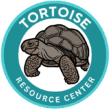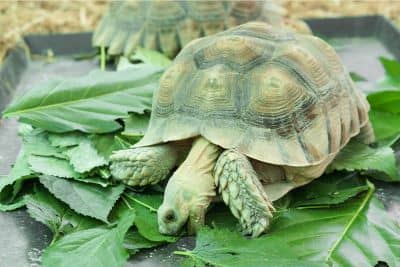If you’re raising a baby sulcata tortoise, you’ve probably already discovered that feeding these little powerhouses isn’t as simple as tossing some lettuce in their enclosure and calling it a day. Baby sulcatas have incredibly specific nutritional needs, and getting their diet wrong during these crucial first months can lead to serious health problems that will haunt your tortoise for life.
The reality is this: most new sulcata keepers make critical dietary mistakes without even realizing it. You might think you’re providing a healthy, varied diet, but if you’re missing key nutritional components or offering the wrong ratios of nutrients, you could be setting your tortoise up for metabolic bone disease, shell deformities, or growth problems that can’t be fixed later.
Here’s the good news though—once you understand what baby sulcatas actually need nutritionally, feeding them properly becomes a straightforward part of your daily routine. This guide will walk you through everything you need to know to give your baby sulcata the nutritional foundation for a long, healthy life.
Why Baby Sulcata Nutrition is Different from Adult Nutrition
Baby sulcata nutrition is a complex balance of calcium, protein, hydration, and fiber—all adjusted for a rapidly growing shell and skeleton.
Baby sulcatas aren’t just smaller versions of adult tortoises—they’re growing machines with dramatically different nutritional requirements. During their first year, a healthy baby sulcata can increase its body weight by 500% or more. This isn’t just getting bigger; their bones are developing, their shells are hardening, their organs are maturing, and their digestive systems are learning to process increasingly complex plant matter.
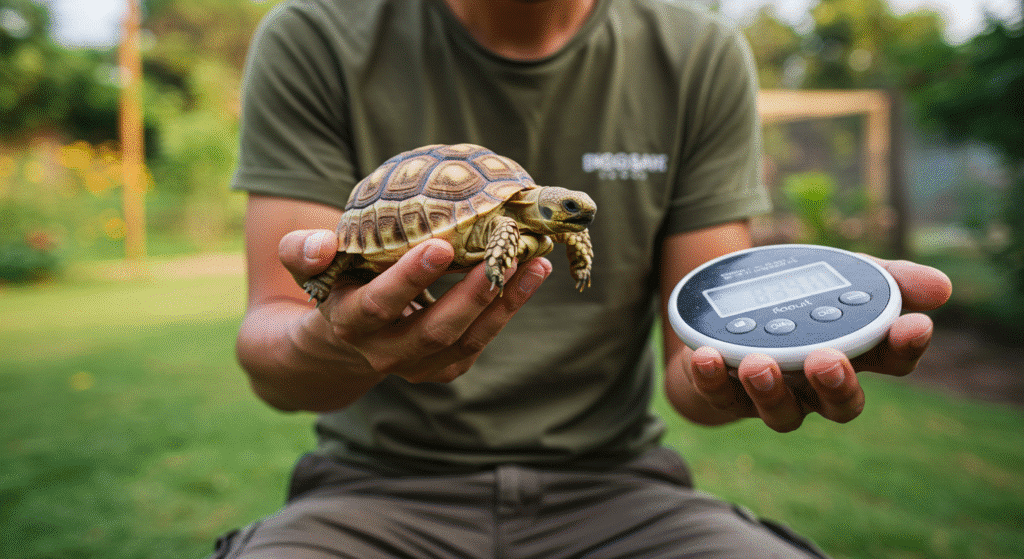
This rapid development means baby sulcatas need higher protein levels, more frequent feeding, different calcium ratios, and a more carefully controlled diet than adults. What works for a 50-pound adult sulcata can actually harm a rapidly growing hatchling.
Baby sulcatas have incredibly specific nutritional needs, and getting their diet wrong during these crucial first months can lead to serious health problems that will haunt your tortoise for life.
That’s why understanding baby sulcata nutrition is the single most important part of raising a strong, healthy tortoise.
The window for getting this right is narrow. The nutritional foundation you provide in the first 6-12 months will literally shape your tortoise’s shell, bone structure, and overall health for the next 50+ years. There are no do-overs when it comes to early development.
The Foundation: Understanding Sulcata Digestive Systems
Before diving into specific foods, you need to understand how baby sulcatas process nutrition. These tortoises are hindgut fermenters, meaning they rely on beneficial bacteria in their large intestines to break down complex plant fibers and extract nutrients. This makes baby sulcata nutrition especially sensitive to fiber type and quality, since their developing gut bacteria can’t yet process coarse or dry material efficiently.
In babies, this digestive system is still developing. The bacterial colonies they need for proper digestion are still establishing themselves, which means baby sulcatas can’t handle the same high-fiber, tough plant matter that adults thrive on. They need softer, more easily digestible plant material with higher nutritional density.
This is why you can’t just feed a baby sulcata the same diet as an adult and expect good results. Their digestive systems simply aren’t ready for that level of complexity.
Daily Feeding Requirements for Baby Sulcatas
Feeding Frequency: Baby sulcatas under 6 months should be fed daily. Some keepers even feed twice daily for very young hatchlings, offering a morning and afternoon meal. As they approach 6-12 months, you can transition to feeding every other day, but daily feeding is generally preferred for optimal growth.
Portion Sizes: A good rule of thumb is to offer an amount of food roughly equal to the size of your tortoise’s shell. This might seem like a lot, but remember—they’re growing rapidly and have high metabolisms. Your baby sulcata should be able to finish most of what you offer within a few hours.
Feeding Schedule: Offer food in the morning when temperatures are rising and your tortoise is becoming active. This gives them the entire day to digest their meal while temperatures are optimal. Never feed late in the evening when temperatures are dropping.
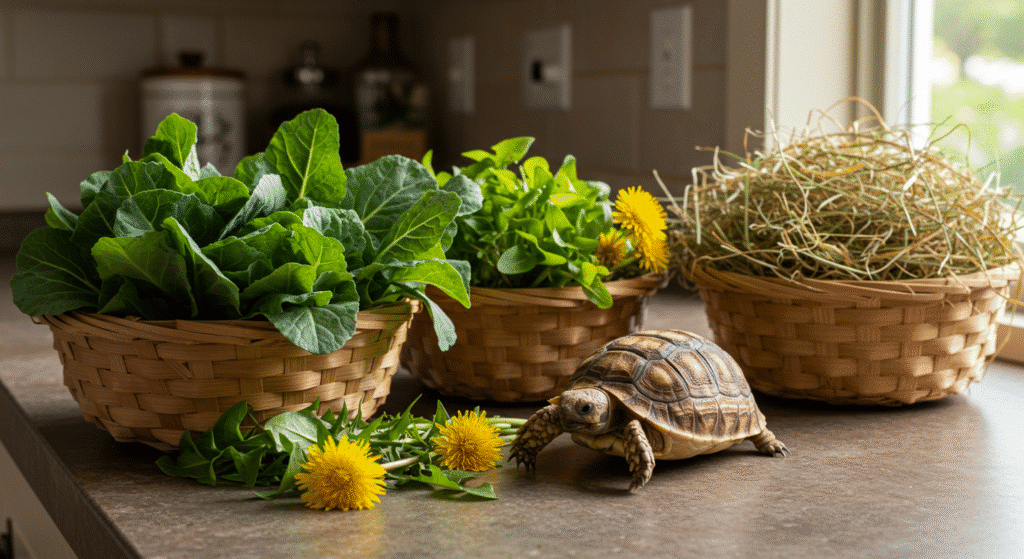
The Core Diet: What Baby Sulcatas Should Eat Daily
The foundation of baby sulcata nutrition lies in a balanced mix of tender grasses, calcium-rich greens, and small amounts of vegetables and treats.
High-Quality Grasses (40-50% of diet): Despite what many care sheets say, grasses should form the foundation of your baby sulcata’s diet from an early age. However, for babies, you need softer, more tender grass varieties:
- Bermuda grass (young, tender shoots)
- Timothy hay (soaked to soften)
- Orchard grass hay (soaked)
- Fresh wheat grass
- Young dandelion plants (entire plant including roots)
The key is offering these in a form that baby sulcatas can actually digest. Soaking dried hays for 10-15 minutes before feeding makes them much more manageable for young digestive systems.
Calcium-Rich Greens (30-35% of diet): These should be dark, leafy greens with excellent calcium-to-phosphorus ratios:
- Collard greens (calcium powerhouse)
- Mustard greens
- Turnip greens
- Dandelion greens
- Endive
- Escarole
Avoid spinach and chard, which contain oxalates that can bind calcium and make it unavailable for absorption.
Safe Vegetables (10-15% of diet):
- Squash (butternut, acorn, yellow)
- Sweet potato (small amounts, high in vitamin A)
- Carrots (grated or finely chopped)
- Bell peppers (red and yellow are highest in vitamins)
- Cucumber (mostly water, but safe filler)
Occasional Treats (5% of diet maximum):
- Prickly pear cactus pads (remove spines)
- Hibiscus flowers and leaves
- Rose petals (pesticide-free)
- Small amounts of melon or berries
Foods That Will Harm Your Baby Sulcata
This is where many keepers go wrong. Some foods that seem healthy can actually cause serious problems for baby sulcatas:
Never Feed:
- Iceberg lettuce (nutritionally worthless and can cause diarrhea)
- Spinach and chard (oxalates bind calcium)
- Avocado (toxic to reptiles)
- Rhubarb (contains oxalic acid)
- Mushrooms (can be toxic)
- Any fruit as a primary food source
- Dog or cat food (completely inappropriate nutrition)
- Bread, pasta, or processed foods
Limit Severely:
- Fruits should make up less than 5% of the total diet
- Cruciferous vegetables like broccoli and cabbage (can interfere with thyroid function in large amounts)
- High-phosphorus vegetables like corn
Protein Requirements: The Misunderstood Nutrient
Here’s where a lot of sulcata keepers get confused. Protein plays a vital role in baby sulcata nutrition, but it must come from the right plant-based sources. Adult sulcatas need very low protein diets, but babies actually require more protein to support their rapid growth. However, this doesn’t mean you should be adding animal protein to their diet.
Baby sulcatas should get their protein from:
- Young, protein-rich grass shoots
- Fresh legume plants (clover, alfalfa plants)
- High-quality commercial tortoise pellets designed for growth
The target protein content for baby sulcata diets should be around 12-15%, compared to 6-8% for adults. This higher protein supports healthy shell and bone development without causing the kidney problems associated with excessive animal protein.
Are You Starving Your Tortoise?
Save 10% on premium tortoise food and supplements from Tortoise Resource Center on Amazon now using code BUYNOWGET10

Sulcata Vitamin & Mineral Topper Supplement
30-Day Supply | 2 oz (56 g)
$24.99
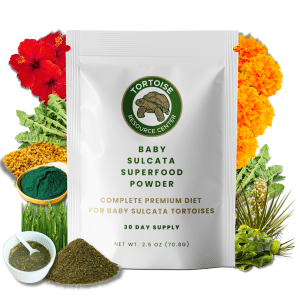
Baby Sulcata Tortoise Superfood Powder
30-Day Supply | 2.5 oz (70.8 g) Bag
$24.99
Commercial Diets: When and How to Use Them
High-quality commercial tortoise pellets can be a valuable part of a baby sulcata’s diet, but they shouldn’t be the primary food source. Good pellets can provide consistent nutrition and fill nutritional gaps that might exist in fresh food diets.
Choosing the Right Pellets: Look for pellets specifically designed for growing tortoises with:
- 12-15% protein content
- High calcium content
- No artificial colors or preservatives
- Timothy hay as a primary ingredient
For keepers who want a comprehensive nutritional foundation, our Baby Sulcata Superfood Powder is formulated specifically for the unique requirements of growing sulcatas, providing the right protein levels and nutrient ratios without the guesswork.
How to Use Them: Pellets should make up no more than 25% of your baby sulcata’s total diet. Soak them briefly in water to make them easier to digest, and offer them as part of a varied meal rather than as the sole food source.
Once the basics of daily feeding are in place, supplements become the next pillar of baby sulcata nutrition, ensuring growth stays balanced and healthy.
Supplementation: Beyond Just Calcium
While calcium is crucial (as covered in our detailed calcium guide), baby sulcatas need additional supplementation to ensure optimal nutrition:
Vitamin Supplements: A high-quality reptile multivitamin should be dusted on food 1-2 times per week. Look for supplements that include:
- Vitamin A (crucial for eye and respiratory health)
- Vitamin D3 (if UVB exposure is limited)
- B vitamins (support metabolism and growth)
We’ve developed our Vitamin and Mineral Topper specifically to address the comprehensive nutritional needs of growing tortoises, including the trace minerals that are often missing from basic calcium supplements.
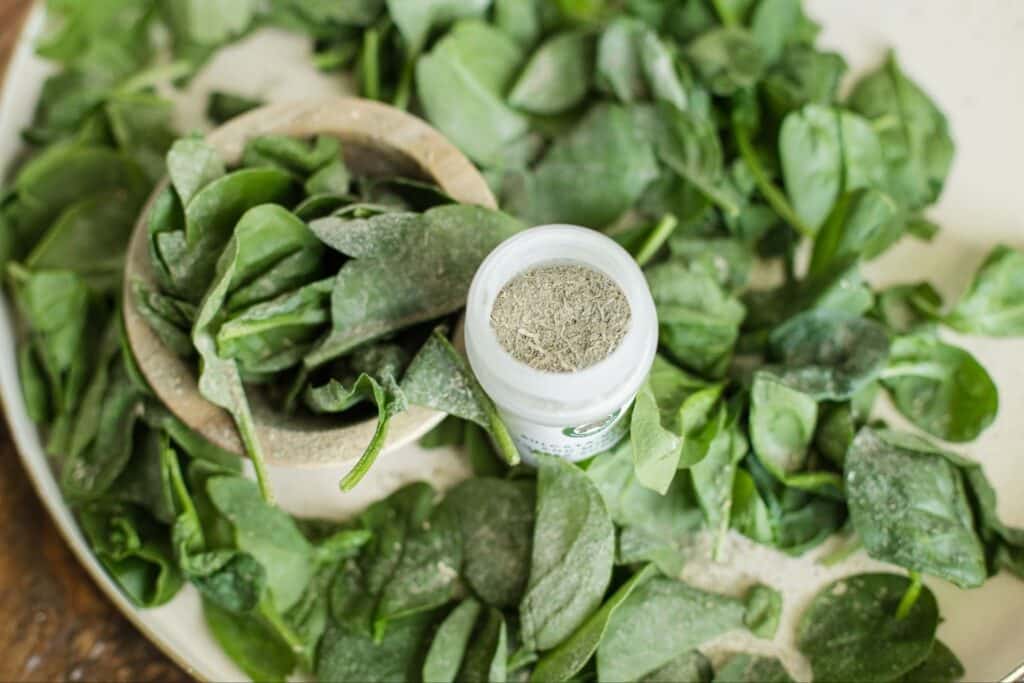
Mineral Supplements: Beyond calcium, baby sulcatas benefit from:
- Trace minerals like selenium and zinc
- Magnesium (works with calcium for bone development)
- Iron (but not too much, as excess iron can be harmful)
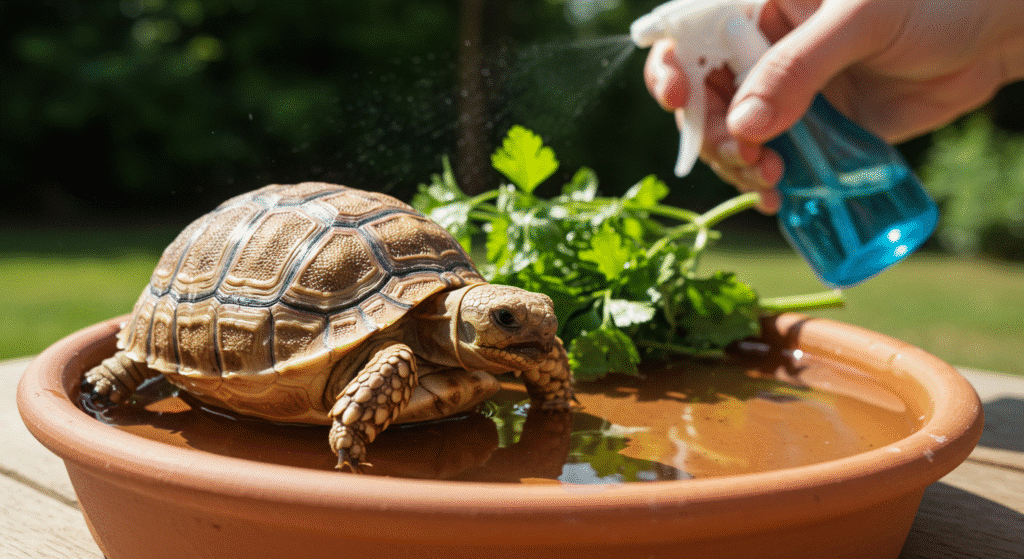
Hydration: The Often-Overlooked Requirement
Baby sulcatas need more hydration than adults, and they get much of this from their food. This is another reason why fresh, water-rich vegetables should make up a significant portion of their diet.
Providing Water:
- Always have fresh, clean water available
- Soak your baby sulcata 2-3 times per week in shallow, lukewarm water
- Choose water-rich vegetables like cucumber and squash
- Mist food lightly before serving to increase moisture content
Dehydration can quickly become life-threatening in baby sulcatas, so hydration should be a daily consideration.
Age-Based Feeding Transitions
0-6 Months: Focus on softer foods with higher nutritional density. Soak dried hays, offer tender grass shoots, and finely chop harder vegetables. Feed daily with possible twice-daily feeding for very young hatchlings.
6-12 Months: Begin introducing more variety and slightly tougher plant matter. Reduce soaking time for hays and start offering larger pieces of vegetables. Continue daily feeding.
12-18 Months: Transition toward more adult-like foods while maintaining higher protein levels. Begin offering whole dandelion plants and longer grass pieces. Can begin feeding every other day if growth is steady.
18+ Months: Continue transitioning toward adult nutrition levels while monitoring growth rates. Reduce protein content gradually and increase fiber content.
Common Nutritional Mistakes That Cause Long-Term Problems
Mistake #1: Too Much Fruit Many keepers think fruit is healthy, but high sugar content can cause digestive problems and contribute to abnormal growth patterns. Fruit should be an occasional treat, not a regular food.
Mistake #2: Inadequate Variety Feeding the same few foods repeatedly can lead to nutritional deficiencies. Baby sulcatas need exposure to different plant nutrients to develop properly.
Mistake #3: Poor Calcium-to-Phosphorus Ratios Even with calcium supplementation, feeding too many high-phosphorus foods can prevent proper calcium absorption.
Mistake #4: Feeding Adult Diets Too Early Rushing to feed high-fiber, low-nutrition adult foods can prevent proper growth and development in babies.
Mistake #5: Inconsistent Feeding Sporadic feeding schedules can stress young tortoises and impact their growth rates.
Signs of Nutritional Problems
Watch for these warning signs that indicate dietary issues:
Growth Problems:
- Extremely rapid growth with soft shell
- Stunted growth with hard, normal shell
- Uneven growth patterns
Shell Issues:
- Pyramiding (raised, pyramid-shaped scutes)
- Soft shell areas
- Abnormal coloration or texture
Behavioral Changes:
- Lethargy or excessive sleeping
- Loss of appetite
- Unusual aggression or hyperactivity
Physical Symptoms:
- Runny nose or eyes
- Difficulty walking or moving
- Visible swelling around joints
Creating a Sustainable Feeding Routine
The key to long-term success is creating a feeding routine that you can maintain consistently. This means:
Meal Prep: Prepare several days’ worth of food at once, storing pre-cut vegetables in the refrigerator. This makes daily feeding much more manageable. Having reliable supplements like our Baby Sulcata Superfood Powder on hand means you can ensure consistent nutrition even when fresh food prep gets hectic.
Seasonal Adjustments: Plan for seasonal availability of foods. Know what you can grow yourself, what’s available locally, and what you might need to source from specialty suppliers.
Emergency Planning: Always have backup food sources available. Frozen vegetables, high-quality pellets, and preserved hays can bridge gaps when fresh foods aren’t available.
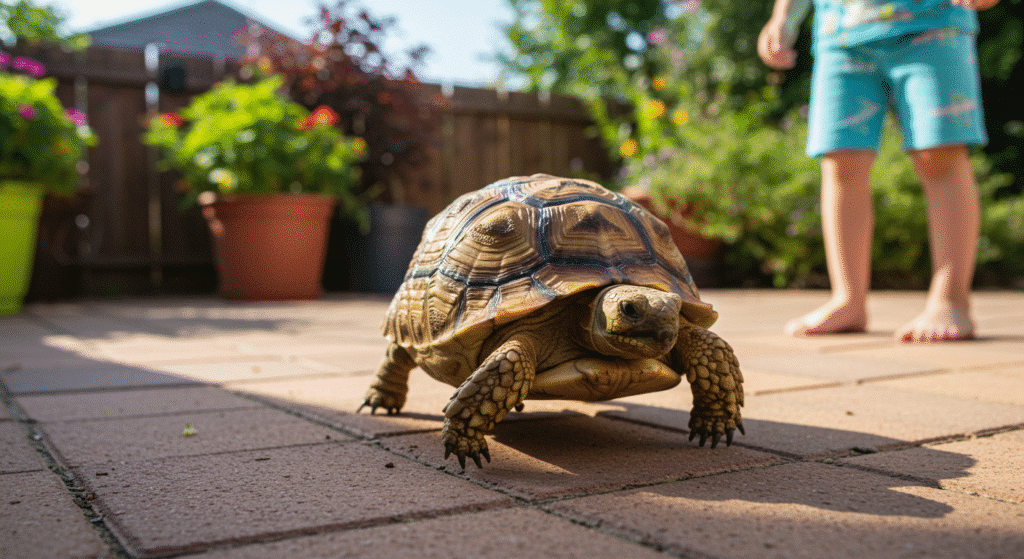
The Long-Term Payoff
Getting baby sulcata nutrition right requires effort, attention to detail, and consistency. But the payoff is enormous. Baby sulcatas that receive proper nutrition from the start develop:
- Strong, properly-formed shells
- Robust immune systems
- Healthy growth rates without deformities
- Good digestive health that lasts for life
- Better resistance to disease and stress
The nutrition you provide in these first critical months literally shapes your tortoise’s entire future. Invest the time and effort now, and you’ll have a healthy, thriving tortoise that can live for 50+ years. Cut corners on nutrition, and you may spend years and thousands of dollars trying to address health problems that could have been prevented.
Your baby sulcata is counting on you to provide the nutritional foundation for a long, healthy life. With the right knowledge and consistent care, you can give them exactly what they need to thrive and grow into the magnificent tortoise they’re meant to become. Your baby sulcata is counting on you to provide the best nutrition possible. Learn more about baby sulcata nutrition and care in our free bonus pack!
